In my review of Diriliş: Ertuğrul I never dealt with the section at the end of the Guardian article; the one about it all being a load of government propaganda:
Parallels between the nationalist sentiment evoked by the drama and Turkey’s political reality under president Recep Tayyip Erdoğan have been made. Erdoğan’s presidency has been mired in accusations of autocracy and censorship following the failed coup of 2016.
At an award ceremony in Turkey in the same year, Erdoğan extolled the series for “entering the nation’s heart”. But Sevda Alankuş, a professor at Yaşar University in Turkey, said that a “discourse of populism fed by nationalism and conservatism” and fuelled by Erdoğan’s government was being deployed through popular culture dramas such as Ertuğrul to “rewrite history”.
Of course we shouldn’t be surprised, water is wet, and all art is political, very much including Western art. (Though I try not to let it interfere with my enjoyment of a good TV show). Having read the above quote before I started watching Ertuğrul, I did keep my propaganda sensor running in the background, and managed to spot a few likely examples that were interesting enough to follow up.
The more I read and tried to understand this, as an outsider whose only exposure to Turkish culture is through these TV shows, the more interested I became in one particular piece of really old Ottoman propaganda; the identity of the revered patriarch of the Ottoman empire: Süleyman Şah.
Or more likely in reality, Gündüz Alp.
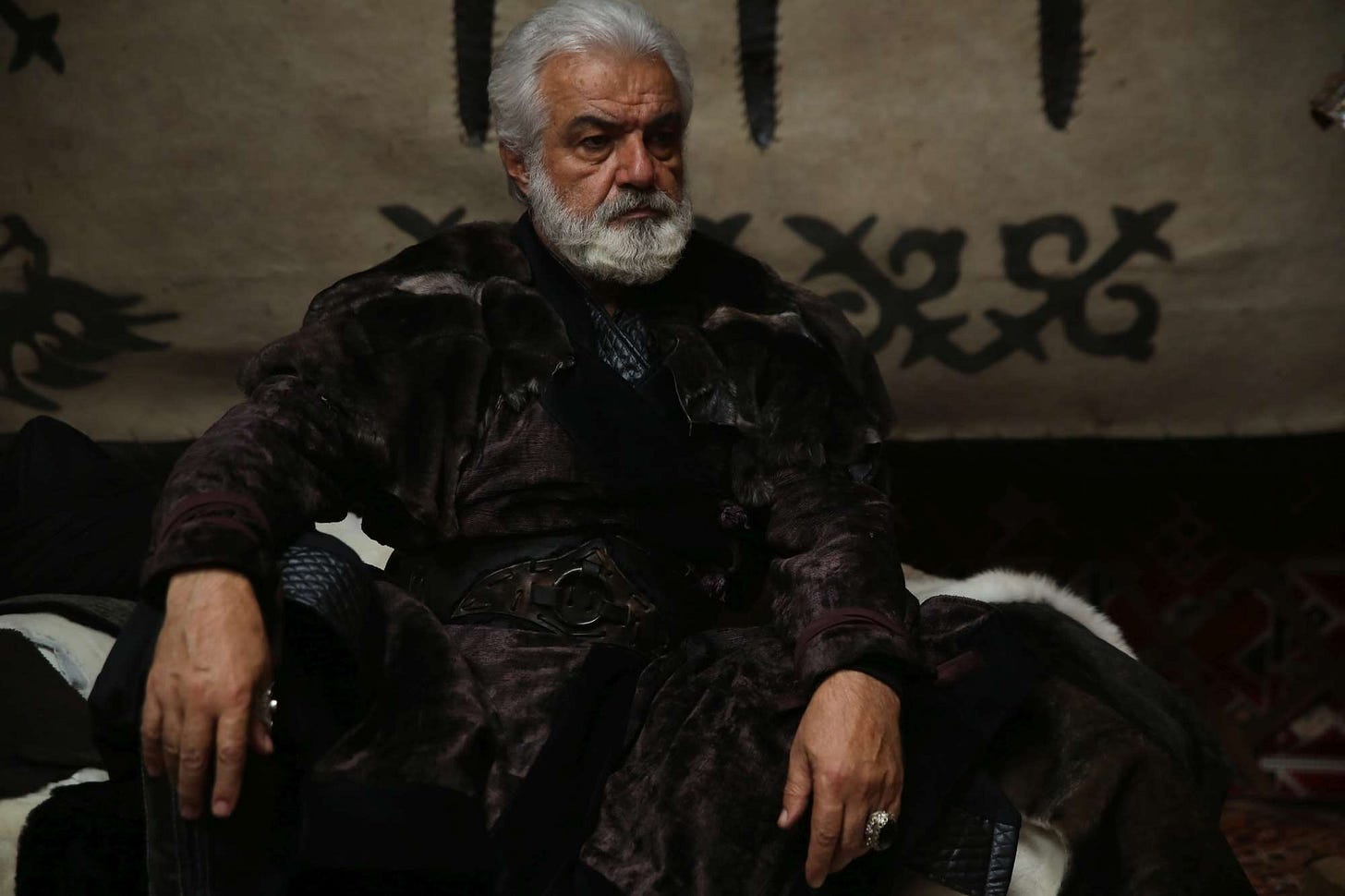
We are all so used to seeing Süleyman Şah (played by Serdar Gökhan) portrayed as Ertuğrul’s father in Diriliş: Ertuğrul, that it seems like an established fact. Indeed, the tomb of Süleyman Şah has been venerated for centuries, due to his status as the supposed grandfather of Osman. Since the Franco-Turkish war, the tomb has actually been located in Syria, but remains Turkish property; the 1921 Treaty of Ankara states that it "shall remain, with its appurtenances, the property of Turkey, who may appoint guardians for it and may hoist the Turkish flag there". When ISIL threatened to attack the site in 2014, Turkey sent a force of “572 soldiers […] 39 tanks and 57 armoured vehicles” into Syria, dismantled the tomb and brought the ancestral remains back closer to the Turkish border where they could keep a better guard over it.
The consensus now though, including the authoritative Türkiye Diyanet Vakfı (Turkish Religious Foundation; TDV) seems to confirm Gündüz Alp as patriarch. So where did the alternative Süleyman Şah narrative come from? The actual evidence is scattered, and most of it is in Turkish, so it took me ages to puzzle through it all. Here is my attempt to write it all in one place in English, while I still have all the browser tabs open.
1. The Coins
As a starting point; the phrase “rewrite history” is not exactly correct in the case of Ertuğrul and Osman, because the early histories were never written down to begin with. Because the Turks were nomadic at the time depicted in the TV shows, all of their history was oral. This slowly changed as they built or conquered forts and towns and took on a more settled lifestyle, but almost everything from the early days of the empire is lost. As a result, there has been a fine tradition of later Ottoman leaders filling in the gaps by writing down into “fact” particular stories that suited their aims at the time, often hundreds of years later. Osman’s family tree seems to be a good example.
Süleyman Şah's Wikipedia page lists five separate historical sources featuring himself as patriarch, but it’s notable that the earliest of these was written in 1456-1459, i.e. at least 130 years after Osman is supposed to have died. Two slightly earlier sources report the alternative family tree, where Ertuğrul’s father is named as Gündüz Alp, but everyone simply ignored those…
… until the discovery of the coins.
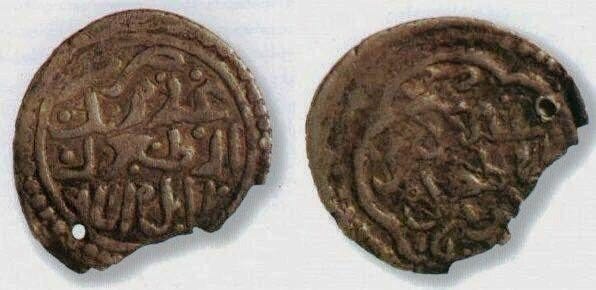
Historian Caroline Finkel published an excellent chronicle [ref. 1] of the Ottoman dynasty in 2005. This seems by far the most reliable source of historical facts for an English speaking casual reader such as myself. She points out the lack of physical evidence remaining from the beginnings of the empire:
If the only artefact which has come down to us from the time of Osman - an undated coin - is genuine, it suggests that Ertuğrul was a historical personage, for it bears the legend ‘Minted by Osman son of Ertuğrul’.
In 2005 when her book was published, this seems to have been the generally accepted truth. A single undated coin is indeed difficult to verify without the context provided by related artifacts. If you happen to dig up a coin in a rubbish pit for example, you could carbon-date the organic matter next to it, and learn all sorts of things from what was thrown away at the same time as the coin. But nothing like this is available, and particularly nothing written. There aren’t any surviving official documents from the court of Osman; the oldest known is an edict issued by his son Orhan dated 1324 (and it’s thought Osman died around then). There are, however, some written accounts by other contemporary local groups (one Byzantine historian mentions a local commander getting his butt kicked by Osman in 1302).
Around 1980, İbrâhim Artuk found the coin pictured above in the collection of the İstanbul Archaeology Museum, and wrote a paper [ref. 2] about it. That’s where the translated inscription quoted by Finkel comes from. The paper is in some relatively obscure conference proceedings (I didn’t manage to get a copy) which surely contributed to the doubts about the coin’s authenticity, and Artuk had trouble reading the final line after ‘Minted by Osman son of Ertuğrul’.
Then some wild rumours started circulating that another coin had been found in a private collection, and importantly, this one was much more legible: it supposedly read ‘Minted by Osman son of Ertuğrul son of Gündüz Alp’. However, no-one had access to the second coin, and the only photo available was of poor quality, and so no-one really believed it was genuine: Finkel doesn’t even mention it in 2005.
By the time a third coin was identified, this time in the Doha Museum in Qatar, the evidence was starting to stack up. Hakan Yılmaz somehow got hold of a decent photo of the second coin, and published a pair of papers [ref. 3 and 4] reanalysing all three.
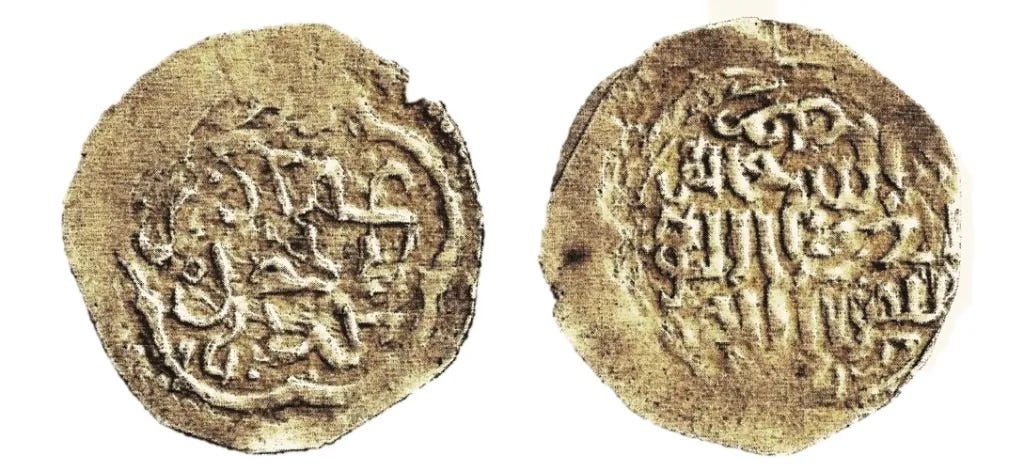
Now comparing these coins is obviously not easy, due to their age, the fact that they are written in an Ottoman Turkish script, and the fact that the coin-stamping technology just wasn’t very good yet. After a long time staring at Yılmaz’s papers, I think I understand him as follows:
The “reverse” faces of all three coins (that’s the face on the left in both the above pictures) have the same inscription: ضرب عثمان بن ارطغرل [ بن ] كندز الپى “Ḍarebe ʿOs̠mān bin Erṭuġrul [bin] Gündüz Alpī” (remember Arabic scripts are written right-to-left)
If you’re having trouble orienting yourself, the loop in the top line “ضرب” is easily spotted in the first coin, but almost smudged out for the third coin; for the latter the most easily identified part is the hooked character looking a bit like a pound symbol (£), located at about the 2 o’clock position of the left-hand face. I think this must be the right-most character in “عثمان بن”, or the letter ‘ayn’ عـ equivalent to a Latin ‘O’.
So to Osman, the fact that his grandfather was Gündüz Alp was so important that he stamped it on his very first coins when he declared his empire. The reason, according to Yılmaz, is that at the time the other Turkish lords were still independent. Osman needed the Gündüz ancestry to prove his descent from Oğuz Han, showing his eligibility to rule over the other Oğuz-descended tribes. That ancestry, plus some deeds of valour such as his conquering of Yenişehir (both the coins pictured above were apparently minted there) was enough to make the other Beys swear allegiance in ~1300.
How then, could the alternative Süleyman Şah ancestry be successfully introduced only 130 years later? Although we may never know for sure, I find it hard to believe that Gündüz Alp goes from extremely important with his name printed on the money, to forgotten altogether in such a short period. It seems more likely that poor old Gündüz was deliberately forgotten in the 15th century, as the alternate Süleyman Şah narrative suited their purposes better. Some of the other “facts” introduced into the historical record around the same time give us a clue as to what that purpose might have been.
2. Osman’s Dream
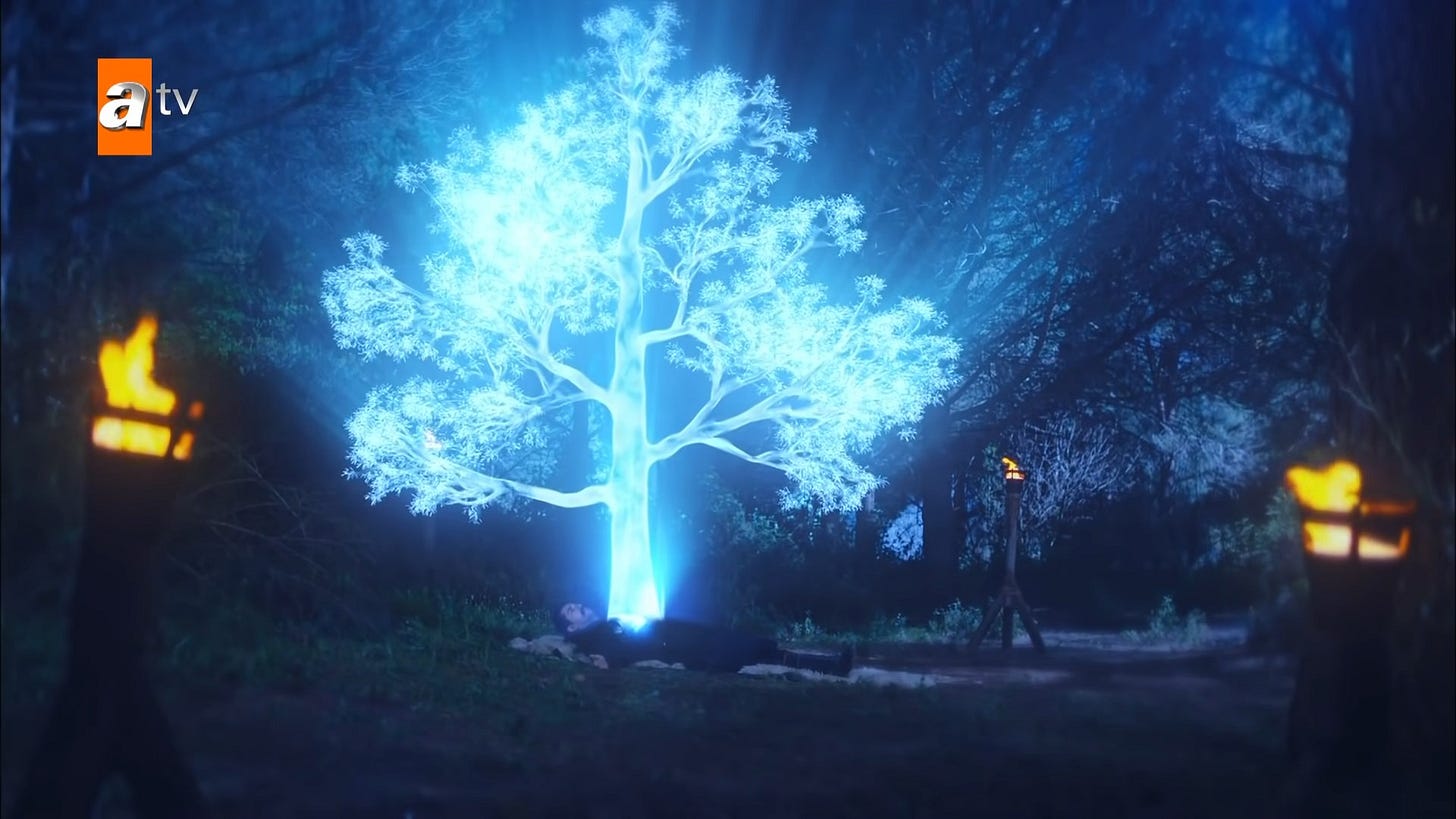
The title of Caroline Finkel’s book, Osman’s Dream, refers to a prophetic dream the eponymous founder of the empire supposedly had while staying at the house of holy man Şeyh Edebali, depicted with suitable reverence in this scene from Kuruluş: Osman, S01E022 (timestamp 41:07). Finkel calls this dream, which is said to have resulted in the marriage of Osman to Edebali’s daughter:
…one of the most resilient founding myths of the empire.
…but points out that it wasn’t written down in this form until about a century and a half after Osman’s death. I quite like Colin Imber’s description of the significance of this myth (I’ve no access to the paper, but Wikipedia quotes him as follows):
The attraction of Aşıkpasazade's story was not only that it furnished an episode proving that God had bestowed rulership on the Ottomans, but also that it provided, side by side with the physical descent from Oguz Khan, a spiritual descent. [...] Hence the physical union of Osman with a saint's daughter gave the dynasty a spiritual legitimacy and became, after the 1480s, an integral feature of dynastic mythology.
The problem was, as time went by it became harder to base the empire on Gündüz Alp’s success, since any eye-witnesses were long dead. Finkel lists a succession of myths that followed the “Dream”, each one designed to shore up the right of the dynasty to rule, as the memory of its founder’s exploits faded. In the late 15th century the idea was introduced that the original parcel of land near Söğüt was granted to Osman’s father Ertuğrul by the Sultan himself, thus legitimising the Ottomans as the heir to the Seljuks. The particular Sultan chosen for this story is Alâeddin Keykûbad, whose reign was regarded as a something of a Golden Age.
The TV show loves this particular story and has a great time dramatising it. The Sultan is portrayed as an almost godlike figure. The actor chosen to play him, Burak Hakkı, is 191 cm tall (6 ft 3 in) and won the “Best Model of Turkey” beauty contest in 1994. When we first meet the Sultan, he is in disguise as a “simple merchant”, which was so obviously not true based on his dress and regal bearing that I almost laughed out loud.
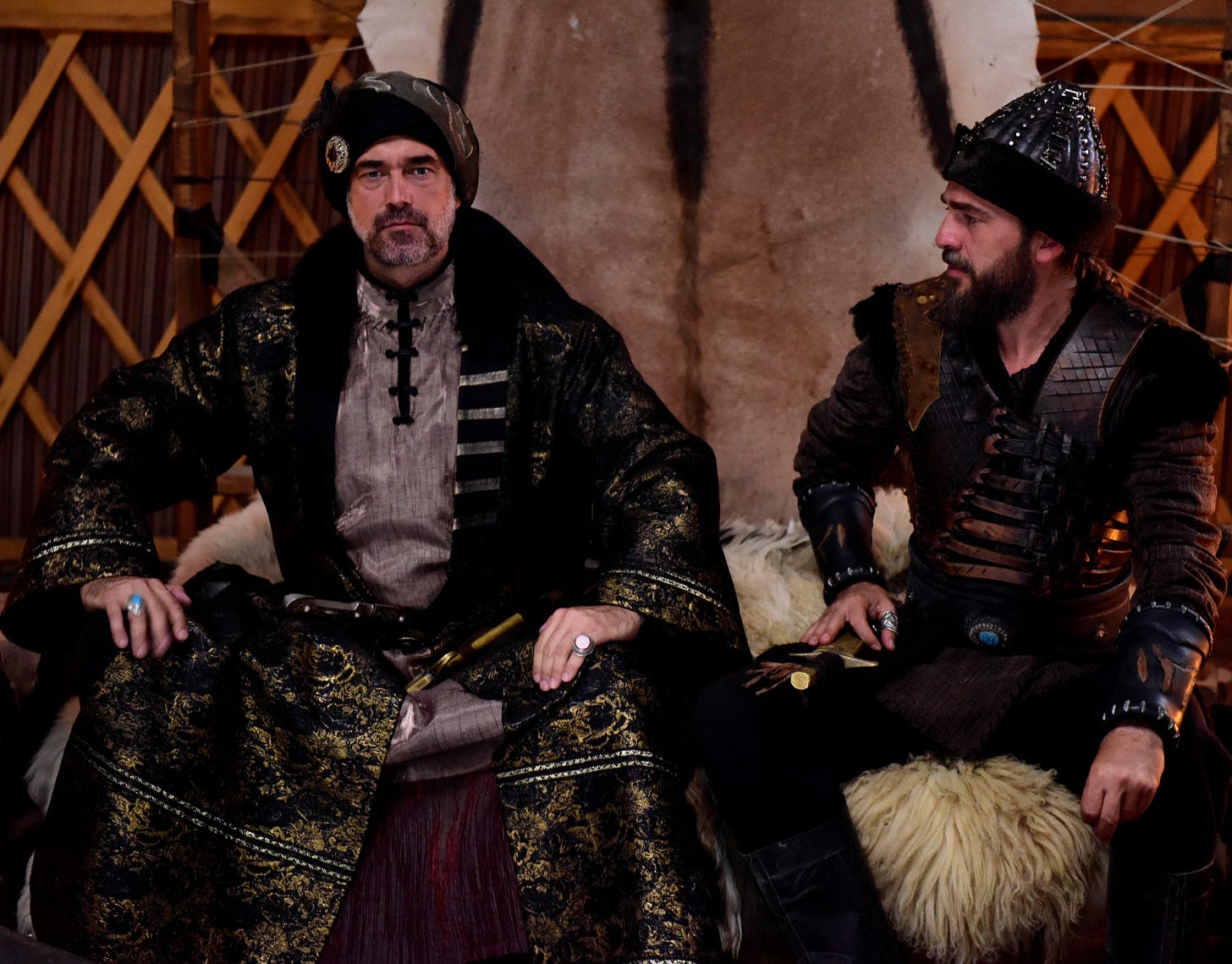
More important than his physical appearance is his prowess in battle. To understand this, you must know an important trope from shows like Ertuğrul, where success in battle and your time of death are pre-determined by Allah. The viewers can predict the outcome of any particular sword fight based on the rank of the participants (except when e.g. the plot requires them to suffer a temporary defeat). Basically, in the Ertuğrul universe you are guaranteed to lose any fight against an enemy who outranks you, and conversely, you will win any fight where you outrank your opponent. In a one-on-one duel, Sergeants will always defeat common soldiers on the battlefield, and are defeated in turn by Commanders. If two fighters of equal and opposite rank meet, in that case the “good guy” wins. This means that Ertuğrul himself, as the highest ranking “good guy”, can never lose a fight unless the baddies bring overwhelming numbers, or ambush him with some sort of trickery.
What rank does the Seljuk Sultan have, based on his abilities with a sword? Check out this scene (Diriliş Ertuğrul 88, timestamp 13:25) where we see him rescue Ertuğrul from one of the aforementioned ambushes. He’s so godly I’m surprised his eyes aren’t glowing. He strides onto the battlefield, towering over his minions. He barely moves, hardly needs to parry, strikes enemies down with precise slow-motion blows without breaking a sweat. Do you really want to argue with this guy over Ertuğrul’s right to rule this land?
The TV show continues the story with the Sultan’s gifts to Ertuğrul confirming his promotion to “Uç Bey” (the first word is pronounced like “Butch” without the “B”, and the whole thing sounds like Pig Latin “ixnay on the Uç Bey”) usually translated as “Margrave” in English. According to Finkel these gifts - a horsetail standard, a drum, and a robe of office in her version of the story - were considered so important as marks of legitimacy that in 1575 an Ottoman chancellor actually forged a set of documents “proving” their authenticity.

So by the 15th century we have the Turkish tribes all happily united in an independent state, and pushing for influence with neighbouring countries. Gündüz isn’t useful anymore - noone outside the Ottomans even remembers who he is. Instead, the legitimacy of the Ottoman empire comes from maintaining the link with the previous empire, the Seljuks. This sets us up for the final piece of the puzzle, the “forgetting” of Gündüz altogether.
3. The Seljuk Ancestry
It turns out that there are actually a whole bunch of different historical Süleymans; “King Solomon” in the Bible is “Sulaimān ibn Dāwūd” in the Quran, and hence “Süleyman” was a popular name for Turkic rulers. Ignoring a couple of earlier and later Süleymans, the two important ones for us are:
Süleyman Alp son of Kaya Alp; this is Osman’s ancestor, and according to the earlier family trees, the grandfather of Gündüz Alp,
and:
Süleyman Şah son of Kutalmış; this guy conquered the city of Nicaea (now called İznik) in 1075, and founded the Turkish offshoot of the Great Seljuk Empire, which was eventually ruled by godly Sultan Alâeddin Keykûbad discussed above.
Now get this; according to historian Âşıkpaşazâde it was Osman himself who deliberately confused the two Süleymans for propaganda purposes. I’m not going to attempt to read the original which Âşıkpaşazâde wrote in 1485, but luckily Halil İnalcık [ref. 5] quotes Osman all nicely transliterated as follows:
Ve eger ol ben Âl-i Selçukîyın der ise, ben hôd Gök-Alp oğlıyın derin.... Süleymanşâh dedem.
This has some archaic words and phrasing that Google Translate stumbles over, but if I’m reading it right, its roughly:
And if they ask if I’m of the Seljuk bloodline, tell them I myself am a descendant of Gök-Alp…. Süleyman Şah is my grandfather.
Thats Gök-Alp to keep the Kayı/Oğuz ancestry, plus Süleyman Şah to add in the Seljuks, for an unbeatable royal bloodline. Just the thing to convince your neighbours that this upstart new empire is the real deal.
Of course we can’t know if Âşıkpaşazâde is telling the story correctly or not, but even if Osman didn’t tell fibs about his own grandfather for political purposes, someone else definitely did in the century and a half after his death. The later family trees have Gündüz Alp demoted to brother of Osman (although its entirely possible that Ertuğrul named one of his sons Gündüz in honour of his own father, back when Gündüz was super important).
4. Conclusion
I’ll leave it up to Caroline Finkel to explain the importance of all this history, true and otherwise:
The past is truly another country in Turkey, whose citizens have been deprived of easy access to the literary and historical works of previous eras by the change of alphabet in 1928 from Arabic script to the Roman alphabet familiar to most of the western world. At the same time, an ongoing programme to make the vocabulary more Turkish is expunging words of Arabic and Persian derivation - the other two components of the rich amalgam that was the Ottoman tongue, today in danger of becoming as ‘dead’ as Latin. On the other hand, works from the Ottoman centuries are now being published in modern script with simplified language, enabling modern readers to gain some understanding of what went before.
This was written in 2005, when the historical dizi TV series were just beginning their meteoric rise associated with international distribution. Finkel again:
Yet, despite the practical hurdles which hinder an understanding of their Ottoman past, the citizens of the modern Turkish state are endlessly curious about their history. Political discourse is peppered with lively exchanges of a kind quite unfamiliar to western observers: varying perceptions of the past provide a rich source of reference as politicians and interest groups quibble over which version of history will best serve tomorrow’s purposes (a tomorrow that has often seemed more uncertain than it is elsewhere). Many conversations allude to topics whose roots stretch back into history. The most visible example of the past haunting the present is the ‘Armenian question’ - which in its current manifestation revolves around Armenians lobbying for national governments to declare the communal massacres in Anatolia in the First World War a genocide. Less obvious to outsiders are two other topics high on the Turkish agenda: the role of the military in politics, and the limits of the acceptable in religious expression.
Although some circumstances e.g. regarding freedom of expression have changed in Turkey under the current government, and you can add some more recent events into the mix (renewed hostilities with Kurds re: Syria, and the failed coup in 2016 being two big examples), the above remains very relevant today.
References:
Caroline Finkel, “Osman's Dream: The Story of the Ottoman Empire, 1300-1923”. United Kingdom, John Murray, 2005. Link
First coin: İbrahim Artuk, “Osmanlı Beyliği’nin Kurucusu Osman Gazi’ye Ait Sikke”, Türkiye’nin Sosyal ve Ekonomik Tarihi (1071-1920): ‘Birinci Uluslararası Türkiye’nin Sosyal ve Ekonomik Tarihi Kongresi’ (11-13 Temmuz 1977) Tebliğleri / Papers Presented to the ‘First International Congress on the Social and Economic History of Turkey, ed.: O. Okyar - H. İnalcık, Hacettepe Üniversitesi, Ankara 1980, s. 27-33.
Second coin: Hakan Yılmaz, “Osman Gâzî’nin Kayıp İkinci Sikkesi ve Osmanlı Kuruluş Tartışmalarına Etkisi”, Âb-ı Hayât’ı Aramak: Gönül Tekin’e Armağan, ed.: Ozan Kolbaş-Orçun Üçer, İstanbul: Yeditepe Yayınları, 2018, ss./pp. 763-788. Link.
Third coin: Hakan Yılmaz, “Osman Gâzî'nin 700/1300-1301'de Yenişehir'de Bastırdığı Üçüncü Sikkesi”, Vak'anüvis Uluslararası Tarih Araştırmaları Dergisi / International Journal of Historical Researches, Yıl: IV, Söğüt Özel Sayısı (Aralık/December 2019), ss./pp. 81-120. Link 1. Link 2.
Halil İnalcık, "Osmanlı Beyliği'nin Kurucusu Osman Beg (Osman Beg, The founder of Ottoman Dynasty)", Belleten, Ankara, 7 (261): 503, 2007. Link.


